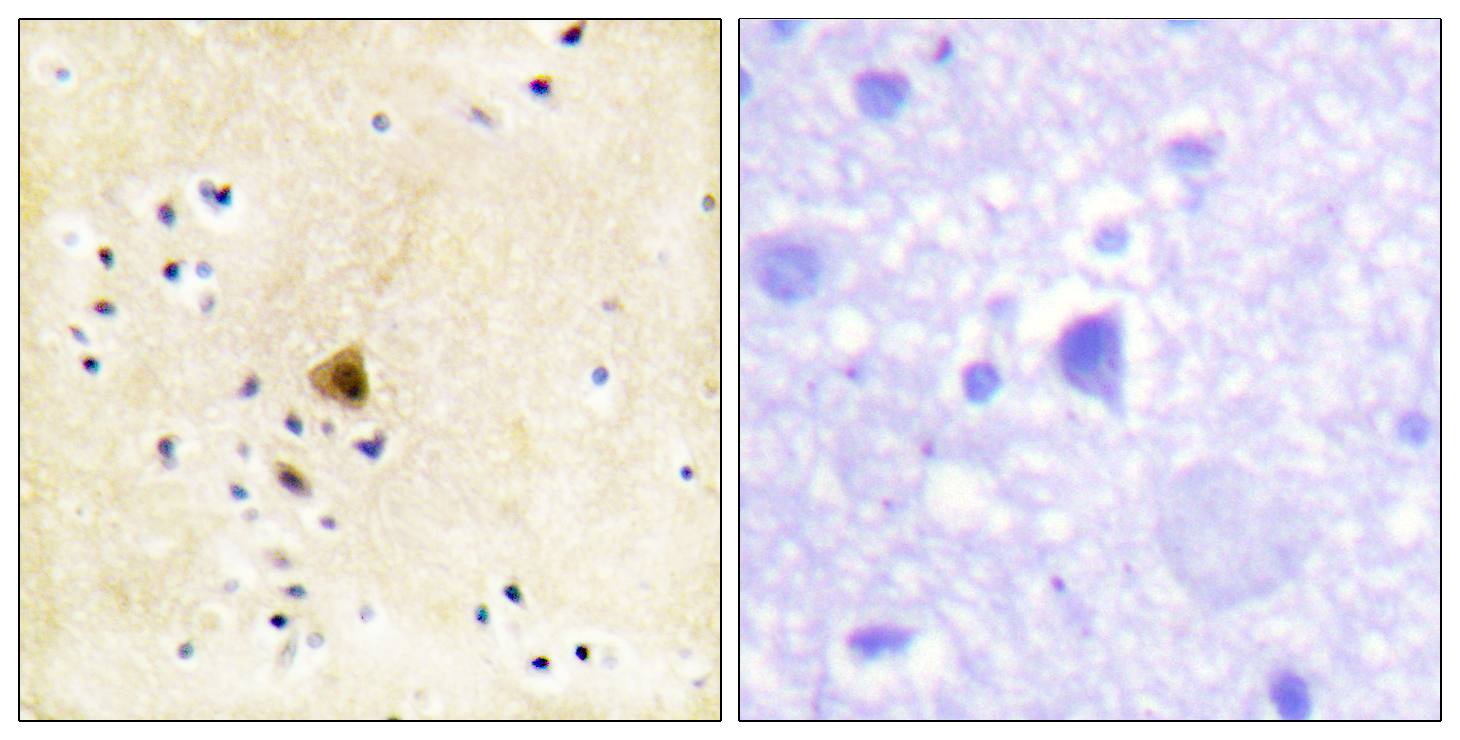RyR-2 Polyclonal Antibody
- Catalog No.:YT4196
- Applications:WB;IHC;IF;ELISA
- Reactivity:Human;Mouse;Rat
- Target:
- RyR-2
- Fields:
- >>Calcium signaling pathway;>>cAMP signaling pathway;>>Cardiac muscle contraction;>>Adrenergic signaling in cardiomyocytes;>>Apelin signaling pathway;>>Circadian entrainment;>>Insulin secretion;>>Oxytocin signaling pathway;>>Pancreatic secretion;>>Prion disease;>>Pathways of neurodegeneration - multiple diseases;>>Hypertrophic cardiomyopathy;>>Arrhythmogenic right ventricular cardiomyopathy;>>Dilated cardiomyopathy;>>Diabetic cardiomyopathy
- Gene Name:
- RYR2
- Protein Name:
- Ryanodine receptor 2
- Human Gene Id:
- 6262
- Human Swiss Prot No:
- Q92736
- Mouse Gene Id:
- 20191
- Mouse Swiss Prot No:
- E9Q401
- Rat Gene Id:
- 689560
- Rat Swiss Prot No:
- B0LPN4
- Immunogen:
- The antiserum was produced against synthesized peptide derived from human RyR2. AA range:2774-2823
- Specificity:
- RyR-2 Polyclonal Antibody detects endogenous levels of RyR-2 protein.
- Formulation:
- Liquid in PBS containing 50% glycerol, 0.5% BSA and 0.02% sodium azide.
- Source:
- Polyclonal, Rabbit,IgG
- Dilution:
- WB 1:500-2000 IHC 1:100 - 1:300. IF 1:200 - 1:1000. ELISA: 1:5000. Not yet tested in other applications.
- Purification:
- The antibody was affinity-purified from rabbit antiserum by affinity-chromatography using epitope-specific immunogen.
- Concentration:
- 1 mg/ml
- Storage Stability:
- -15°C to -25°C/1 year(Do not lower than -25°C)
- Other Name:
- RYR2;Ryanodine receptor 2;RYR-2;RyR2;hRYR-2;Cardiac muscle ryanodine receptor;Cardiac muscle ryanodine receptor-calcium release channel;Type 2 ryanodine receptor
- Observed Band(KD):
- 200-300kD
- Background:
- This gene encodes a ryanodine receptor found in cardiac muscle sarcoplasmic reticulum. The encoded protein is one of the components of a calcium channel, composed of a tetramer of the ryanodine receptor proteins and a tetramer of FK506 binding protein 1B proteins, that supplies calcium to cardiac muscle. Mutations in this gene are associated with stress-induced polymorphic ventricular tachycardia and arrhythmogenic right ventricular dysplasia. [provided by RefSeq, Jul 2008],
- Function:
- developmental stage:Expressed in myometrium during pregnancy.,disease:Defects in RYR2 are the cause of catecholaminergic polymorphic ventricular tachycardia type 1 (CPVT1) [MIM:604772]; also known as stress-induced polymorphic ventricular tachycardia (VTSIP). CPVT1 is an autosomal dominant form of arrhythmogenic disorder characterized by stress-induced, bidirectional ventricular tachycardia that may degenerate into cardiac arrest and cause sudden death.,disease:Defects in RYR2 are the cause of familial arrhythmogenic right ventricular dysplasia 2 (ARVD2) [MIM:600996]; also known as arrhythmogenic right ventricular cardiomyopathy 2 (ARVC2). ARVD is an autosomal dominant disease characterized by partial degeneration of the myocardium of the right ventricle, electrical instability, and sudden death. It is clinically defined by electrocardiographic and angiographic criteria; pathologic findi
- Subcellular Location:
- Sarcoplasmic reticulum membrane ; Multi-pass membrane protein . Membrane ; Multi-pass membrane protein . Sarcoplasmic reticulum . The number of predicted transmembrane domains varies between orthologs, but both N-terminus and C-terminus seem to be cytoplasmic. .
- Expression:
- Detected in heart muscle (at protein level). Heart muscle, brain (cerebellum and hippocampus) and placenta.
- June 19-2018
- WESTERN IMMUNOBLOTTING PROTOCOL
- June 19-2018
- IMMUNOHISTOCHEMISTRY-PARAFFIN PROTOCOL
- June 19-2018
- IMMUNOFLUORESCENCE PROTOCOL
- September 08-2020
- FLOW-CYTOMEYRT-PROTOCOL
- May 20-2022
- Cell-Based ELISA│解您多样本WB检测之困扰
- July 13-2018
- CELL-BASED-ELISA-PROTOCOL-FOR-ACETYL-PROTEIN
- July 13-2018
- CELL-BASED-ELISA-PROTOCOL-FOR-PHOSPHO-PROTEIN
- July 13-2018
- Antibody-FAQs
- Products Images

- Western Blot analysis of HepG2-UV MOUSE-BRAIN AD293 PC-3 cells using RyR-2 Polyclonal Antibody diluted at 1:2000

- Immunohistochemistry analysis of paraffin-embedded human brain tissue, using RyR2 Antibody. The picture on the right is blocked with the synthesized peptide.



